How To Save Tomato Seeds: It’s Easier Than You Think
As an Amazon Associate and member of other affiliate programs, I earn from qualifying purchases.
If you’re wondering how to save tomato seeds, then chances are you’ve fallen in love with growing tomatoes. And when you save seeds from your favorite tomato plants, you don’t have to worry about buying seeds next year.
There are other benefits to saving tomato seeds like:
- being able to save seed from the healthiest, most vigorous plants and earliest ripening fruit
- knowing your seeds are free of disease and chemicals
- curating a collection of seeds from your favorite varieties
How to save tomato seeds
I used to think that the process for saving tomato seeds was complicated, but it’s actually a lot easier than I thought. And don’t worry. If you don’t want to go through the process of fermenting, I’m going to show you a quick and simple trick that skips that whole step.
3 ways to save tomato seeds.
First I’ll talk about fermenting the seeds because that’s the ideal method.
Fermenting is the preferred method for saving tomato seeds.
The fermenting process removes substances within the tomato gel that inhibit germination and can decrease the chances of passing on any bacterial or fungal disease to the next generation.
It takes about a week, but going through the steps to ferment tomato seeds, makes sure you’re saving the healthiest, highest quality tomato seeds.
Benefits of fermenting tomato seeds:
- higher germination rates
- last longer in storage
- cleaner and prettier seeds
How to save tomato seeds by fermenting
Step 1: Remove the seeds from your tomato
Slice the tomato along the bottom to expose the seed cavities.
Squeeze the seeds into a cup. Any cup will do. You can mix tomato seeds out of fruit from the same variety, but use a different cup for each different type of tomato.
Plastic cups are convenient because you can write the variety name right on them, and they can be washed and reused.
Step 2: Let the seeds ferment
If the tomato wasn’t particularly juicy, add a little water to the seeds and juice in the cup. You need just enough liquid to cover the seeds and meat in the cup.
Cover them with a towel, and set them where you can keep an eye on them so they don’t dry out.
Let them ferment for 3 to 7 days. They may get a little mold growing on the top. That’s okay.
Step 3: Rinse and let dry
When they’re done fermenting, rinse the tomato seeds by adding more water and stirring. Then carefully pour off the mold and excess water. Repeat until the water is clear and the seeds are free of debris.
When they’re clean, lay them out to dry on a paper towel. Give them a full week to dry out before you store them to prevent mold growth during storage.
Gather the seeds into a labeled envelope and keep them in a cool dry place.
How to save tomato seeds without fermenting
Saving tomato seeds without fermenting is absolutely doable, and if you’re short on time this is the way to go. All you have to do is slice open your tomato and squeeze out the seeds while you smear them across a paper towel.
Let them dry on the paper towel for a week or so. Once they’re completely dry, you can simply fold up the paper towel and place it in a bag or envelope.
The only negatives we have observed about saving seeds this way is that sometimes the seeds are slow to germinate, and if you leave any bits of paper towel on when you germinate them you can get some mold growth.
The third way to save tomato seeds
Just leave a few tomatoes to rot in your garden, and the fermentation process will occur naturally outdoors. You totally skip the step of harvesting tomato seeds, but in the spring, you’ll still have some tomato plants sprouting.
You won’t have control over when they come up or be able to plant them deep for good root structure. And there’s always a chance they’ll pop up too early and get killed by frost.
So it’s not the best way of preserving tomato seeds for planting. And I don’t recommend relying on this method of saving tomato seeds, but it does work.
We had a cherry tomato plant pop up in a crack in the concrete next to our porch. We used the porch railings to tie it up all summer and it made for convenient snacking. 🙂
Issues with fermenting tomato seeds
Since the seeds need to ferment for about a week, they will start to grow some mold and may even get a little smelly. And if you’re saving seed from a lot of tomatoes, they can take up a lot of space.
If it starts to bother you and it’s been more than 3 days, just go ahead and process them.
The worst thing, honestly, is if your tomatoes start to attract flies. Tiny fruit flies will go nutty for fermenting tomato seeds, and they can be really annoying if they get inside your house.
Make a homemade trap by mixing some raw ACV with a drop of dish soap and a drop of syrup in a little jar or cup and set it next to your fermenting tomato seeds. It helps trap any little flies that might come around.
These ready-made fly traps also work really well when placed among the cups of fermenting seeds. It lasts a long time, and the package comes with 6 refillable traps.
How many tomatoes should you save for seed?
The number of seeds per tomato varies a lot depending on the variety. But it’s a good guess that you can get at least 20 seeds from one tomato. So a home gardener usually only needs to save seed from one tomato of each variety.
However, you can save as many as you want and share your bounty with good friends!
Storing tomato seeds
Tomato seeds will store for several years if kept dry and cool.
Once they’re completely dry, you can save them in paper envelopes, plastic baggies, empty prescription bottles, or small jars. Store them in their container in the refrigerator or a cool, dark place.
You can expect them to germinate pretty well the first 3 years after they’re saved. After that, the germination rate will start to decline, but they’re still worth a trying to grow even up to 8 years in storage.
Here’s a pretty cool thread on Tomatoville about starting tomato seeds that are over 40 years old!
Will you be saving tomato seeds this year?
When you’re ready to plant your tomato seeds, make sure you read our guide to starting tomato seeds indoors.


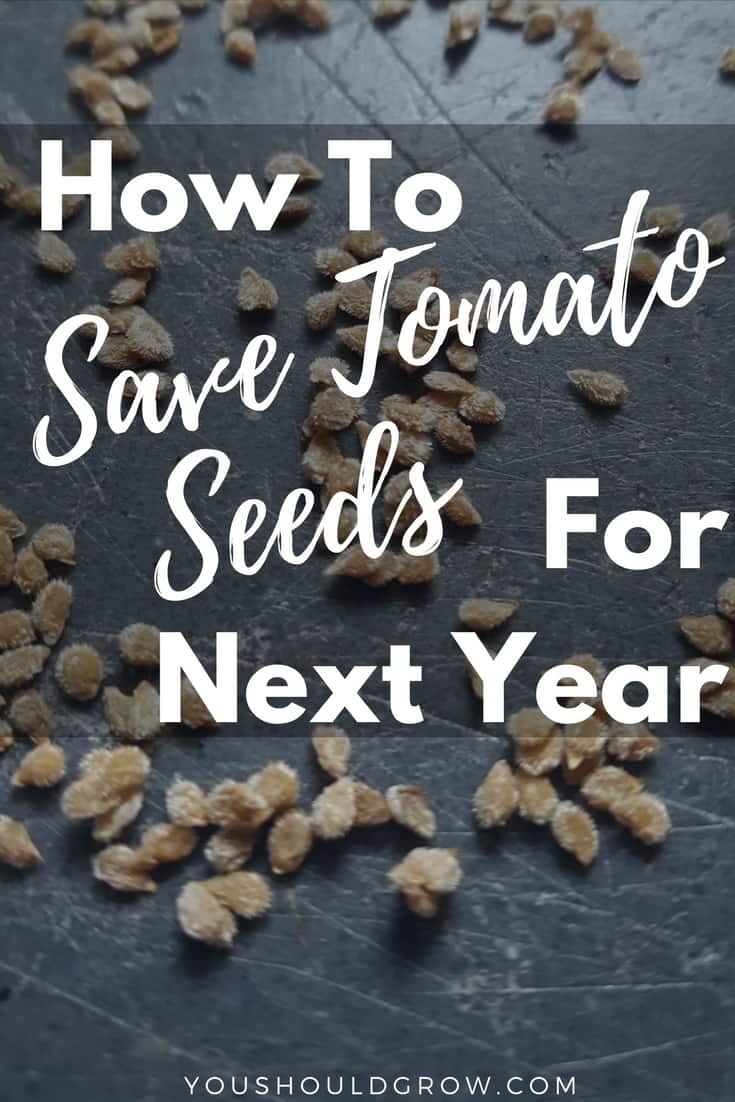
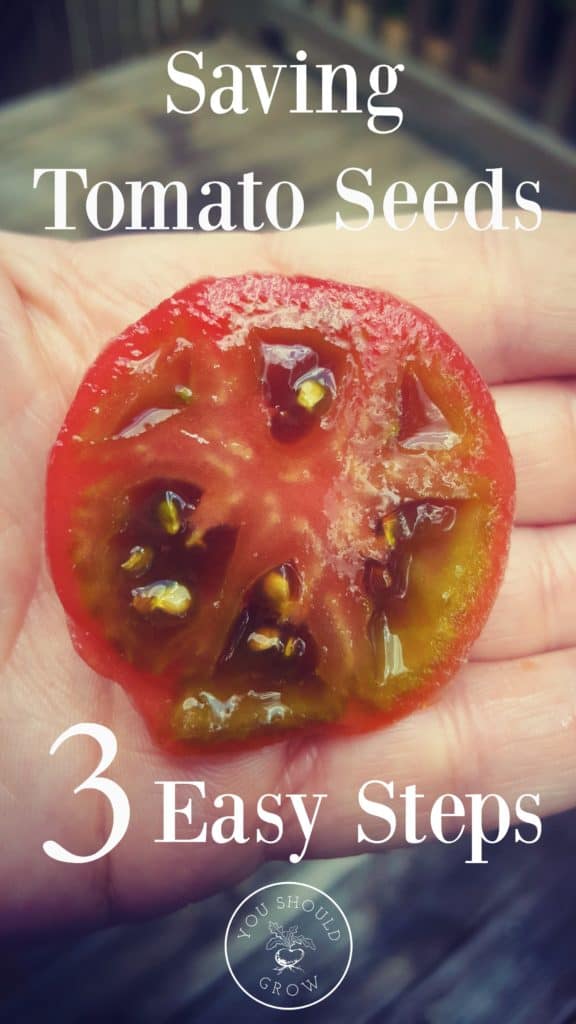
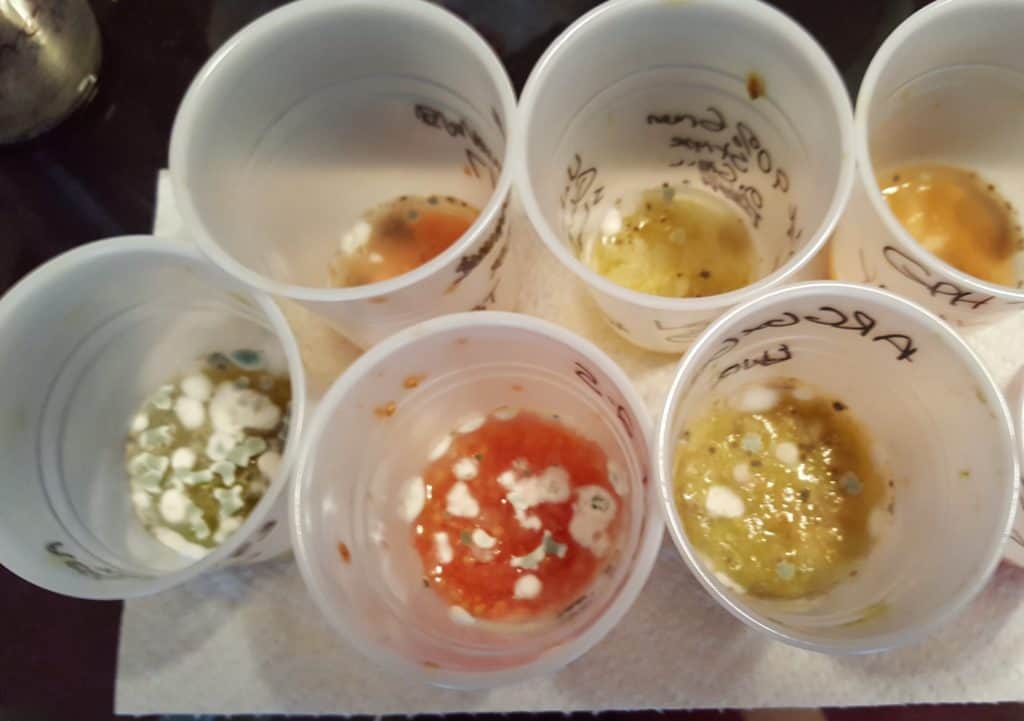
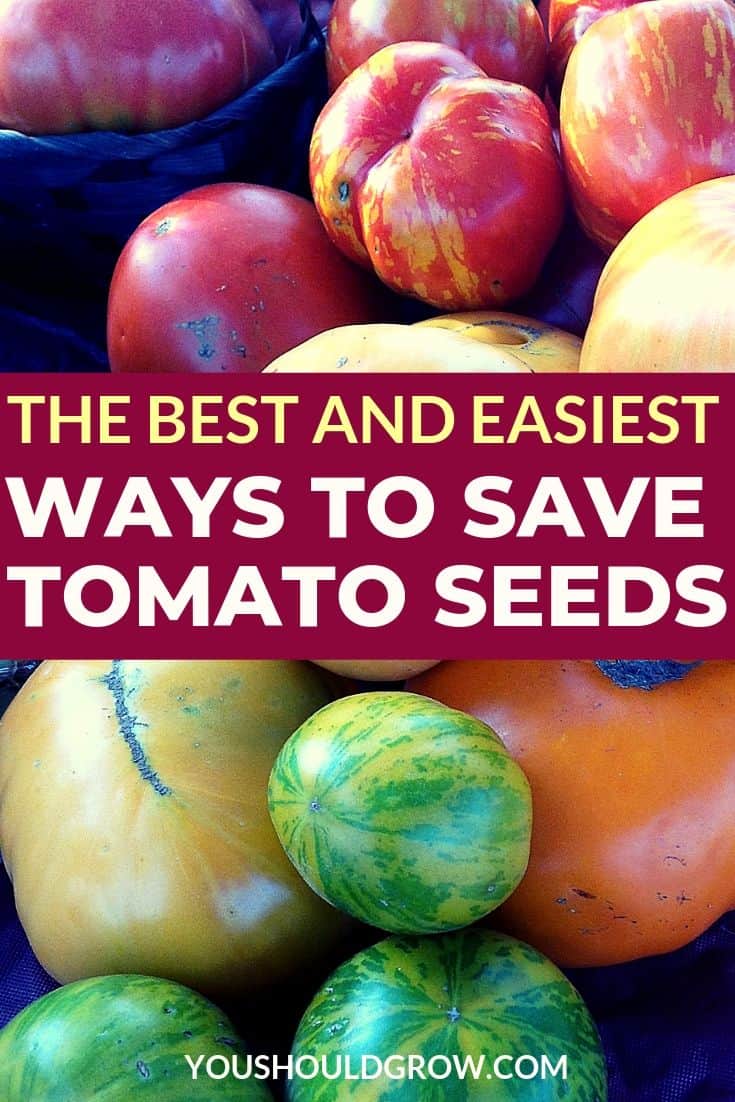
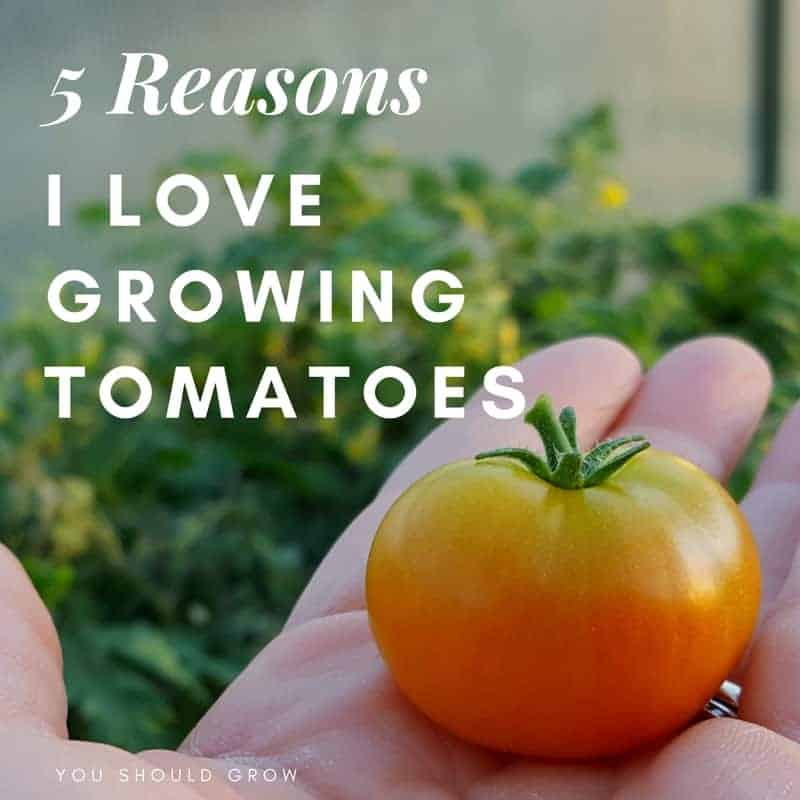




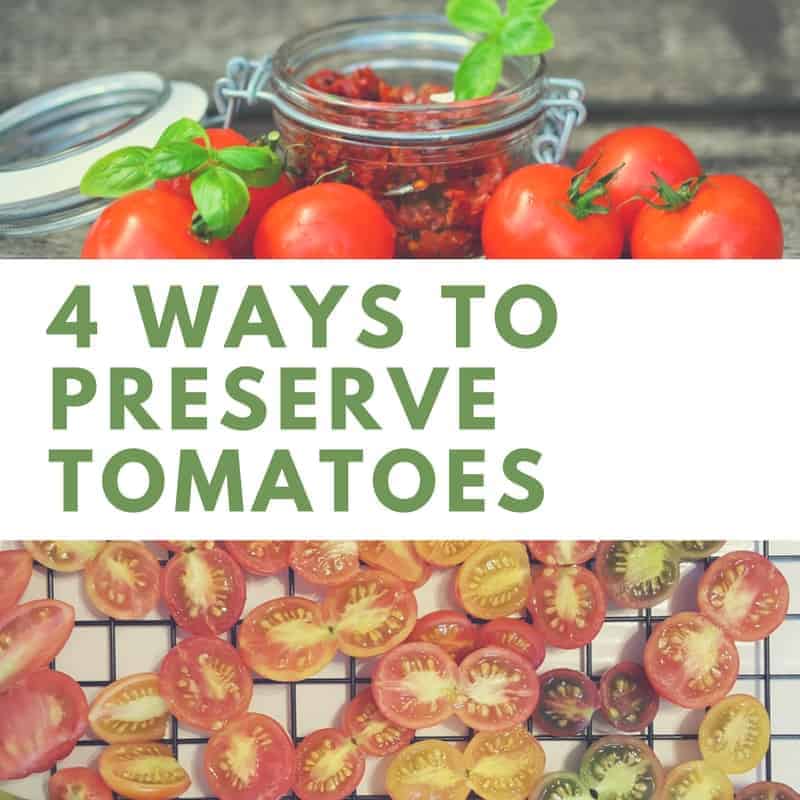
I love saving tomato seeds! There’s a cup of them on my kitchen counter right now. 🙂
Yay! More tomatoes for next year! 🙂
Very nice, informative article! Thanks so much for sharing!
Thanks, Jamie!
Thank you very informative !
Thank you for this! My hubby and I have been wanting to try this. I am pinning!
Saving seeds is awesome, thanks for the informative tips. Harvesting tomato seeds can be time consuming. I just let mine dry out on paper towels or sometimes even wax paper. With the wax paper it’s easier to gather them after they dry.
Hey, Carole! We do that too sometimes! I hadn’t thought about wax paper, though. Great tip!
Very interesting! I’m curious as to why you have to ferment them before you dry & save them. My grandfather also saved his seeds, but I don’t recall him using the fermenting process, just drying. I’m still new to gardening and would appreciate any info. Thanks so much!
Hi Debra! Good question! Thank you for asking. Fermenting removes the gel coating the seed which contains natural germination inhibitors and may harbor tomato diseases. You don’t have to ferment the seeds. You definitely can just dry them. But you should get better germination when the seeds have been fermented.
If we save seeds from our garden tomatoes we have several advantages. First of all, we will have seeds for the new season at a low price. But the most important we will have the advantage that the new generation will be more adapted to the soil and the conditions in our garden. And, last but not least, if we take care year by year to save seeds from the most beautiful and healthy tomatoes, we will get more and more beautiful and healthy fruits. Thus, after several years of saving seeds we will have a perfect adapted variety for both our garden and our taste.
Hi! Thanks for your thoughtful comment! All of those are excellent reasons to save seeds every year!
This was a much needed. Wonderful read. Thank you for taking time to do this!
Thank you, Jordon! I’m glad I could help! 🙂
Can you do this with other veggies/fruits too? Or only tomatoes? Awesome article by the wat
Hi Lisa! Thanks! You can save seed from any veggie, but most do not need to be fermented. For many other veggies, you would just choose an over-ripe fruit, remove seeds, and let them dry on a paper towel. The over-ripe fruit is important because a lot of times the seeds are not fully mature at the point that we eat them. So you look for cucumbers and eggplant to turn yellow, squash and okra that are extra large and wood, and broccoli, lettuces, and similar go to flower then you harvest the seeds after the blooms have dried up. Let me know if you have other questions. 🙂
I usually save my tomato seeds and ferment them for two or three days at room temperature.
In this process the extraneous pulp and gel coating usually is eliminated.
It is also a fact fermenting the seeds improves germination
thanks for info I do not ferment. try them on plastic trays but I find they do not dry completely. and are sticky. should I put them in sun. I will try to ferment some as well. what I also do with the extra seeds I grind them in coffee grinder and put on food. they are full of nutrients. other veggies I do the same.
Hi, Andy! I recommend putting up a fan that will blow over your trays to help dry them out. That would be safer than leaving in the sun which might damage them.
Your articles are fun, and easy to follow. I also read those about citrus fruits, and its incredible how easy it really is. And what a joy to watch from the seed to actually harvesting the fruits. I love it.
Shouldn’t something be said about saving seeds from hybrid or F1 varieties?£
brought back seeds from Italy and grow in the winter in Fla. I went through the whole drying seeds from last year and it worked. But this year i am freezing the best tomatoes from my harvest and will thaw them this fall to try and see if this works. My thought is i will thaw, and crash open the fruit and then plant the whole tomato in the garden and see what comes up. The plants now are just amazing after the 2nd year. Has any one tried this method before and had luck?
Is what I have done is cut slices about 3/16 of an inch and lay them on dirt from my mulch pile. Then cover them up with a little dirt, keep wet and bingo in about two weeks you will have lots of plants.